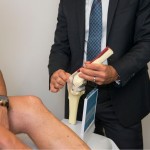
The first part of this is to understand what the ACL is and the role it plays.
ACL stands for “anterior cruciate ligament” and is a tough, fibrous band of tissue and one of two ligaments that connects in the middle of the knee and stabilises the thigh bone (femur) and the shin bone (tibia).
The ACL provides stability to your knee as well as controlling the rotation forces developed during side stepping, pivoting, landing from a jump and sudden stopping.
What causes ACL injuries?
Because of the function of the ACL to provide stability during flexion and rotation, the most common incidence of ACL injuries or tears occur during sports, training and fitness activities occurring in professional, community and recreation sports.
Sports that include pivoting actions such as rugby league, soccer, netball, golf, tennis and skiing particularly rely on the ACL and players of these sports are more susceptible to these types of injuries when stress is placed on the knee. Data also shows us that younger women athletes involved in pivoting sports are at greater risk of incurring ACL injury.
What are the different degrees of ACL injury?
Ligament injuries are graded 1-3 depending upon the severity and the amount of ligament torn.
Grade 1 injuries are classified as minor trauma or ligament sprain. In Grade 1 injuries, the fibres are stretched but not torn.
Grade 2 injuries include more severe trauma. Otherwise called a “partial tear”, in Grade 2 injuries some of the ligament fibres are actually torn.
Grade 3 injuries include severe trauma to the ligament or a “complete tear”, in Grade 3 injuries all fibres of the ligament have been torn.
The ACL is commonly a grade 3 ie. It is almost always a complete tear and is unlikely to only partially tear.
How do you know if you have an ACL injury?
ACL injury signs and symptoms will vary from person to person and for an acute injury, can include the following:
- A “pop”. You may have heard or felt your knee “pop”.
- Immediate swelling of the knee.
- Knee pain.
- Instability – a feeling of the knee giving way or “buckling”
Awareness of how an injury can occur can be one of the best preventions we have available.
Whether you are playing a sport or in a training situation, being aware of some key elements that cause an ACL tear may help you to prevent incurring an injury. These are some of the most common injury triggers:
- A sudden slow down and then change direction
- Pivoting with your foot planted firmly on the ground
- Landing incorrectly from a jump
- Stopping suddenly
- Receiving a direct blow to the knee (ie from a football tackle)
What can I do to prevent an ACL injury?
Although there is no magic ingredient to prevent injury – even for our elite athletes who are in peak condition and work with the guidance of expert exercise physiologists and physiotherapists, there are some fundamental practices you can introduce to your training and pre-game activities that will help. Try to ensure you introduce the following as part of your routine.
- Warm up before exercise. This is particularly important now that the colder weather is here
- Stretch and strengthen ensuring you give attention to the muscles at the front and back of the thigh (quadriceps and hamstrings)
- Include plyometrics exercise. These mimic dynamic moves and involve jumping movements like skipping, bounding, hopping, lunges and jump squats.
- Practice landing with your knees bent after jumping, crouching, pivoting or turning
Does a damaged ACL require surgery?
When the ACL is torn it usually requires reconstructive surgery even if you are not intending to return to pivoting sports. A stable knee protects further articular damage to cartilage and meniscus.
Occasionally (usually older patients) ACL injuries respond well to being treated conservatively to reduce swelling and restore range of motion. Whether a patient is deemed suitable for conservative treatment is based upon the severity of the injury, age, condition of their knee as well as their lifestyle – ie that their day to day work and lifestyle does not require pivoting or sudden change in direction.
If conservative treatment is recommended, it will generally be performed under the guidance of a physiotherapist and will include increasing the strength of the quadriceps and hamstring muscles to assist in compensating the instability of the cruciate ligament deficiency.
When is surgery required and what is involved?
Surgical treatment is required for most patients particularly athletes involved in pivoting sports or for those who work in a role that involves lifting and handling.
I perform ACL reconstruction as an arthroscopic procedure (keyhole surgery). During the reconstruction, the damaged ligament is removed from the knee and replaced with a graft. A graft involves taking a piece of healthy living tissue and transplanting it surgically to create a new ligament.
The goal of the surgery is to stabilise the knee and prevent recurrent instability of the knee buckling during pivotting activities allowing a return to normal activity.
Post surgical rehabilitation is also key in achieving best outcomes and this will be discussed with you prior to your surgery.
It’s important to note that ACL reconstruction surgery is one of the most common surgical procedures performed worldwide by orthopaedic specialists with successful results achieved allowing elite athletes and everyday patients to return to normal function.
Get professional advice for injury management
If you have suffered a knee injury, it’s important to have it properly assessed. It could be treated easily with conservative management or you may need a surgical procedure. Ensuring you get the right advice and timely, suitable treatment will allow you a return to pain free, normal function and activity.
Dr Louis Shidiak
CMO Parramatta Eels and Wentworthville Magpies


